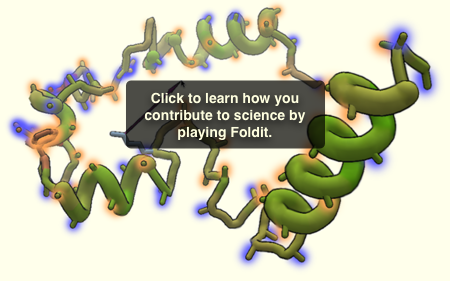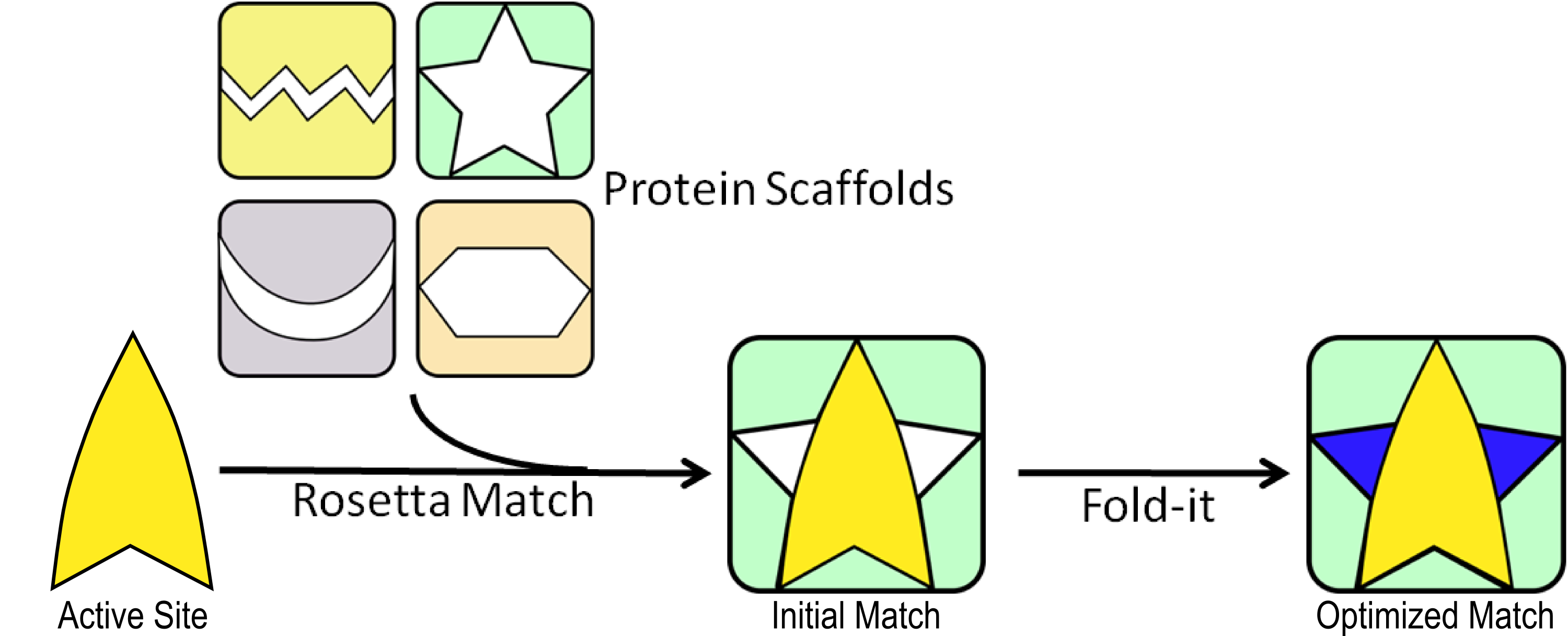Team:Washington/Project/FoldIt
From 2009.igem.org
Problem
Streptavidin in its native form exists as a homotetramer, where adjacent subunits interact allowing for a strong interaction with biotin. This interaction is strong (Kd = 1.5E-15 M at pH 5.0) and can withstand most strong denaturing agents1. However when in its monomeric form, streptavidin does not maintain this strong interaction and its usefulness as a strong binder diminishes. For our system we needed a protein that could: be easily displayed on the surface of the cell, specifically bind a ligand, and release this ligand in the presence of biotin. The ability to display a protein on the cell surface is trivial, however there is difficulty in trying to get a protein to be functional on the surface of the cell. In the case of streptavidin the ability of the protein to form tetramers on the cell surface seems to be hindered, due to the poor ability of cells displaying streptavidin to bind biotinylated fluorophore see display data. From this issue the idea of using a monomeric protein to bind biotin arose.
The Idea
To create a monomeric protein that binds strepavidin we choose to utilize the computational protein design methods, in part developed by the Baker lab at the University of Washington. Several novel proteins have been engineered using these methods, and having the local expertise available and excited about the prospects of this project further encouraged us to explore this route. The general overview of computational protein design is depicted in the schematic below.
The first step is to design an "active site", which describes the geometric constraints of key amino acids that interact with the ligand of interest. Since the structure of streptavidin is already solved we were able to use that as a template. We chose to make geometric constraints describing 5 residues that are making hydrogen bonds to biotin ligand as our "active site". Once the active site has been described it can be run in the program RosettaMatch. This program takes the "active site" description as an input, and searches through a predefined library of protein scaffolds, in which a binding pocket has been defined and all amino acids were converted to alanine, trying to identify ones that can accommodate the "active site". Scaffolds that are able to place all 5 amino acids and the ligand such that there are no steric clashes and the geometric constraints were satisfied are accepted, as depicted in the cartoon below of the yellow triangle fitting into the green star. As one can imagine, while this will fill up some of the binding pocket, additional amino acids will be needed to fill the remaining space and perfect the shape complementarity between the ligand and protein. To do this we are using the program Foldit, developed as a collaboration between the Baker and Popovic labs at the University of Washington, created by Seth Cooper and Adrien Troy. Foldit takes the Rosetta energy function and incorporates it into a GUI from which users can then use to design and/or fold proteins, while evaluating the changes they make with Rosetta energy function in real time. We are using Foldit to optimize our "initial matches" by filling in the gaps.
The Trench Work
While we plan on using Foldit to optimize our matches, we have turned some of our favorites into puzzles currently being showcased on the Foldit website. PLEASE JOIN US IN OUR EFFORTS. GO TO THE Foldit WEBSITE AND PLAY OUR PUZZLE. WE PLAN ON TESTING THE PROTEINS YOU DESIGN!!! We have uploaded several of our favorite matches, but we would like to use YOUR intuition in order to perfect these designs.
As can be seen below Foldit uses an easily learned user interface and uses a score board to show the current player who is the best folder. You can work alone or in teams, share puzzles, and test your protein design abilities against your friends. Below we depict a small set of the MANY options that are available to you in the program Foldit.
|
REPACK, a.k.a. Shake: Here we see a video of Foldit, showing one of our biotin puzzles "Hold Me Tightly". The protein is represented as a cartoon model, showing off its secondary structure as well as key amino acid groups. Steric clashes of the amino acid side chains show up as red balls and can also be observed in the video. These steric clashes can be removed with the Shake Function. The Shake function in Foldit performs coarse sampling of the amino acid conformations, looking for a global-minima. |
|
REDESIGN, a.k.a. Mutate: The function we see here is the Mutate function. This allows the user to sample many amino acids at a particular site, or the whole protein. Mutate looks for global-minima while sampling amino acids. As is seen here Alanine is mutated to Asparagine. The blue and white striped band indicates that a hydrogen bond has been formed, which is a favorable interaction between two polar residues. |
|
MINIMIZE, a.k.a. Wiggle: Another nice feature of Foldit is the ability to select a sphere of amino acids around your ligand, and optimize these amino acids based off of a fine sampling of conformations. Here we see the amino acids surrounding the ligand being selected and having the Wiggle function performed on them. The Wiggle function in Foldit allows the user to fine tune the protein structure. Finding a local-minima for the amino acid conformations. |
This accessible format has allowed over 100,000 users to help design proteins. Currently we have published protein puzzles on Foldit and are screening though the top scoring designs. An undergrad in our group will be active throughout the next year testing the designs and looking for biotin binding proteins.
References
 "
"



